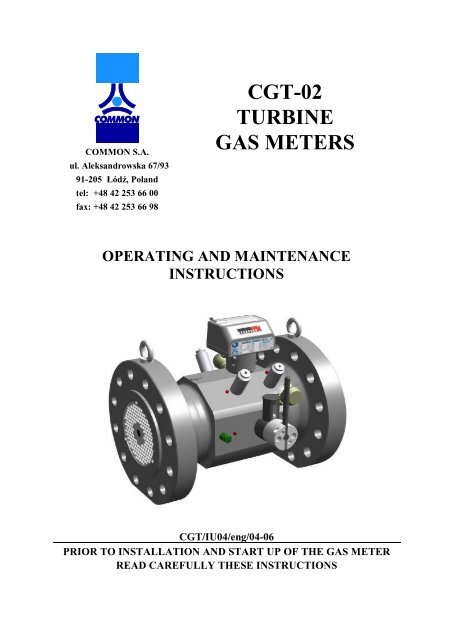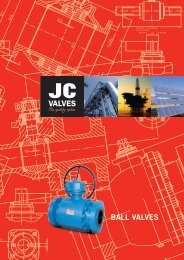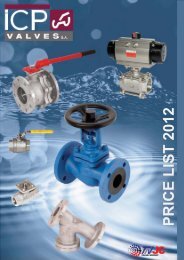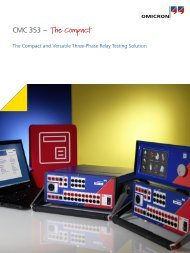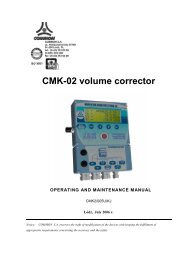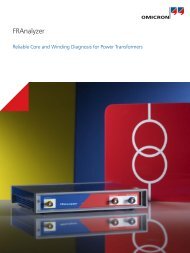CGT-02 TURBINE GAS METERS - firsttech.ro
CGT-02 TURBINE GAS METERS - firsttech.ro
CGT-02 TURBINE GAS METERS - firsttech.ro
Create successful ePaper yourself
Turn your PDF publications into a flip-book with our unique Google optimized e-Paper software.
WUDT-UC-WO-O/19)3. Conformity with the requirements of OIML R6, OIML R32, ISO9951, AGA7Eu<strong>ro</strong>pean Type App<strong>ro</strong>valMet<strong>ro</strong>logical parameters Table 2Operation positionH – standard, ( VD, VU – option, on request)4. Conformity with other standards2:2000PN-EN 12261:2003 (U), PN-92/M-54832.3PN-M-54832-1/A1: 1995,PN-EN 1<st<strong>ro</strong>ng>02</st<strong>ro</strong>ng>08-2+AC:1999, PN-EN 1<st<strong>ro</strong>ng>02</st<strong>ro</strong>ng>16-4:2003,PN-EN 1<st<strong>ro</strong>ng>02</st<strong>ro</strong>ng>50-2:2001, PN-EN ISO 898-1:2001,PN-EN ISO 3506-1:2000, PN-EN ISO 3506-PN-ISO 7005-1:1996, ZN-G-4005,Table 1. Physical p<strong>ro</strong>perties of most popular gases that may be measured with the <st<strong>ro</strong>ng>CGT</st<strong>ro</strong>ng>-<st<strong>ro</strong>ng>02</st<strong>ro</strong>ng>Turbine Gas Meters - density at 101,325 kPa, and at 20 0 CGasorgas mixtureChemicalsymbol(formula)Densityρ[kg/m 3 ]Density relatedto airGas meter executionargon Ar 1,66 1,38 standard IIBnit<strong>ro</strong>gen N 2 1,16 0,97 standard IIBbutane C 4 H 10 2,53 2,1 standard IIBcarbon dioxide CO 2 1,84 1,53 standarde IIBethane C 2 H 6 1,27 1,06 standard IIBethylene C 2 H 4 1,17 0,98 standard IIBnatural gas ≈CH 4 ca. 0,75 ca. 0,63 standard IIBhelium He 0,17 0,14 standard IIBmethane CH 4 0,67 0,55 standard IIBp<strong>ro</strong>pane C 3 H 8 1,87 1,56 standard IIBcarbon monoxide CO 1,16 0,97 standard IIBacethylene C 2 H 2 1,09 0,91 special IIChyd<strong>ro</strong>gen H 2 0,084 0,07 special IICair - 1,20 1 standard IIBBasic met<strong>ro</strong>logical parameters of the <st<strong>ro</strong>ng>CGT</st<strong>ro</strong>ng>-<st<strong>ro</strong>ng>02</st<strong>ro</strong>ng> turbine gas meters are shown in Table 2.This information is not to be considered as a trade offer. App<strong>ro</strong>priate information maybe obtained f<strong>ro</strong>m authorised dealers or f<strong>ro</strong>m the Marketing Department.3
Gas meters create pressure losses in the installation. These values, for the <st<strong>ro</strong>ng>CGT</st<strong>ro</strong>ng>-<st<strong>ro</strong>ng>02</st<strong>ro</strong>ng> gas meters,for the density ρ 0 = 1,2 kg/m 3 , may be determined f<strong>ro</strong>m the chart, Fig. 1.At operating conditions the pressure d<strong>ro</strong>p ∆p rz [Pa] may be calculated f<strong>ro</strong>m the following formula:∆prz=r<strong>ro</strong>pa+ ppa∆pwhere: ρ - gas density, Table 1 [kg/m 3 ],p a - atmospheric pressure (p a ≅ 101 [kPa] ),p - pipeline pressure upstream the gas meter [kPa],∆p - pressure loss at basic conditions (Figure 1) [Pa].∆p[Pa]∆p[mm H 2 O]1000100100DN50DN80DN100DN200DN250DN150DN300101011 10 100 10000.1Q [m 3 /h]Fig.1. <st<strong>ro</strong>ng>CGT</st<strong>ro</strong>ng>-<st<strong>ro</strong>ng>02</st<strong>ro</strong>ng> Turbine Gas Meter pressure loss;gas density ρ o = 1,2 kg/m 34
NominaldiameterGas metersizeMaximumflowQ maxMinimum flow Q minfor pressure ranges1.6; 2 MPa,and rangeability:Minimum flowQ minfor pressure ranges5; 6.4; 11 MPaand rangeability:1:10 1:20 1:30 1:5 1:10 1:20 1:30Gas volume for one LFpulse- - m 3 /h [m 3 /h] [m 3 /h] [m 3 /h] [m 3 /h] [m 3 /h] [m 3 /h] [m 3 /h] [m 3 /pulse]DN 50DN 80DN 100DN 150G 40G 65G 100G 160G 250G 160G 250G 400G 400G 650DN 200 G 1000DN 250DN 3006510016<st<strong>ro</strong>ng>02</st<strong>ro</strong>ng>5040<st<strong>ro</strong>ng>02</st<strong>ro</strong>ng>504006506501000610162540------5813201320323250-----8132<st<strong>ro</strong>ng>02</st<strong>ro</strong>ng>0321320325080508013013<st<strong>ro</strong>ng>02</st<strong>ro</strong>ng>0061016254<st<strong>ro</strong>ng>02</st<strong>ro</strong>ng>54065--81320132032--------0,111Digitalcode*of the metersizeG1000 1600 - 80 50 320 160 80 50 10 41....G 650 1000 - 50 32 - 100 50 32 1 55....G 1600G 1000G 1600G 2500G 1600G 2500G 4000160<st<strong>ro</strong>ng>02</st<strong>ro</strong>ng>500160<st<strong>ro</strong>ng>02</st<strong>ro</strong>ng>500400<st<strong>ro</strong>ng>02</st<strong>ro</strong>ng>50040006500--------801308013<st<strong>ro</strong>ng>02</st<strong>ro</strong>ng>0013<st<strong>ro</strong>ng>02</st<strong>ro</strong>ng>00320508050801308013<st<strong>ro</strong>ng>02</st<strong>ro</strong>ng>00--------6510016<st<strong>ro</strong>ng>02</st<strong>ro</strong>ng>5016<st<strong>ro</strong>ng>02</st<strong>ro</strong>ng>5040<st<strong>ro</strong>ng>02</st<strong>ro</strong>ng>504006503250801308013<st<strong>ro</strong>ng>02</st<strong>ro</strong>ng>0013<st<strong>ro</strong>ng>02</st<strong>ro</strong>ng>0032<st<strong>ro</strong>ng>02</st<strong>ro</strong>ng>032508050801308013<st<strong>ro</strong>ng>02</st<strong>ro</strong>ng>00110101014....15....21....22....23....32....33....34....44....45....51....52....61....62....63....72....73....74....of <st<strong>ro</strong>ng>CGT</st<strong>ro</strong>ng>-<st<strong>ro</strong>ng>02</st<strong>ro</strong>ng> Turbine Gas Meters DN50÷DN3005Table 2. Basic met<strong>ro</strong>logical parameters and digital code
II. CONSTRUCTION AND OPERATIONThe turbine gas meter operation is based on the p<strong>ro</strong>portionality of the <strong>ro</strong>tational speedof the turbine wheel to the linear velocity thus to the flowing gas volume. Gas entering the gasmeter (Fig. 2) is directed th<strong>ro</strong>ugh the inlet flow straightener into the measurement assemblyand causes <strong>ro</strong>tations of the turbine wheel. The turbine wheel <strong>ro</strong>tations are transmitted bymeans of gears and magnetic coupling into the index assembly. The index sums up the volumethat has flown th<strong>ro</strong>ugh the meter, and it is shown on the 8-digit counter. P<strong>ro</strong>per performanceof each <st<strong>ro</strong>ng>CGT</st<strong>ro</strong>ng>-<st<strong>ro</strong>ng>02</st<strong>ro</strong>ng> Turbine Gas Meter is maintained only in the range of Q min and Q max , asdetermined in Table 2.Fig.2. Construction of the <st<strong>ro</strong>ng>CGT</st<strong>ro</strong>ng>-<st<strong>ro</strong>ng>02</st<strong>ro</strong>ng> Turbine Gas Meter7
The <st<strong>ro</strong>ng>CGT</st<strong>ro</strong>ng>-<st<strong>ro</strong>ng>02</st<strong>ro</strong>ng> Turbine Gas Meter (Fig. 2) consists of the following main assemblies:Main body. The main body transfers all loads – those arising f<strong>ro</strong>m gas pressure, as well asf<strong>ro</strong>m the piping. The gas meter bodies f<strong>ro</strong>m DN50 to DN 150, p<strong>ro</strong>vided with PN16 and PN20(ANSI150) flanges, may be executed in two versions: carbon steel or ductile cast i<strong>ro</strong>n. Thebodies for PN50, PN64, PN110 (ANSI300, ANSI600) are made of carbon steel only. Weldedsteel bodies are always made for sizes DN200 and bigger. Each body is p<strong>ro</strong>vided with twoflanges made in accordance with PN-ISO 7005-1:1996. On request other applicable standardsmay be applied. The flange dimensions, as well as overall dimensions and app<strong>ro</strong>ximate weightsof gas meters, are given in Tables 3a and 3b, and in Fig. 14. The main body is p<strong>ro</strong>vided withtaps for the installation of HF transmitters, and taps for pressure and temperature sensors (seeSection III).Measurement assembly. Consists of the turbine wheel, inlet flow staightener andtransmission gear. The turbine wheel is located in the axis of the gas meter and is p<strong>ro</strong>videdwith high precision ball bearings. The inlet flow straightener is placed upstream the turbinewheel in order to symmetrize the gas flow and to direct it onto the turbine wheel vanes. Thetransmission gear (worm gear and cylindrical gear) decreases the <strong>ro</strong>tational velocity andtransfers it to the magnetic coupling.Drive transmission. Consists of the magnetic coupling together with the hermetic partitionhousing. The driving part is placed inside the partition housing and the driven part is placedoutside the partition housing. The magnetic coupling transfers the drive f<strong>ro</strong>m the gas meterpressurised part to the index. The driven part of the magnetic coupling may be equipped with areference wheel that is the inductor of HF transmitters.Index assembly. Consecutive reduction of the <strong>ro</strong>tational speed is performed there (th<strong>ro</strong>ughthe worm gear and cylindrical gear) in order to drive the mechanical totalizer, and inductors oflow frequency pulse transmitters. The assembly contains also sockets for electrical LF and HFoutput signals.Lubrication assembly. The <st<strong>ro</strong>ng>CGT</st<strong>ro</strong>ng>-<st<strong>ro</strong>ng>02</st<strong>ro</strong>ng> gas meters are p<strong>ro</strong>vided with the lubrication system forperiodic lubrication of the turbine wheel bearings (except for DN50 in standard execution).The system consists of the manually driven oil piston pump with the oil container (Fig. 3). Thecontent of the oil container is 2⋅10 -5 m 3 [20 cm 3 ]. Other mechanisms of the gas meter are notlubricated externally; they are p<strong>ro</strong>vided with self lubricated bearings. The lubrication system isvented and filled up with oil in the factory.8
III. INDEX AND MEASUREMENT OUTPUTSThe measurement outputs of the <st<strong>ro</strong>ng>CGT</st<strong>ro</strong>ng>-<st<strong>ro</strong>ng>02</st<strong>ro</strong>ng> Turbine Gas Meter consist of a mechanicalindex and electrical signal outputs. The body is p<strong>ro</strong>vided with taps for installation of externalHF transmitters, and taps for pressure and temperature measurement (option). These outputsenable the cont<strong>ro</strong>l of gas meter operation and connection of external equipment. The locationof measurement outputs on the gas meter is shown in Fig. 3.Mechanical index is located inside the index unit and is visible th<strong>ro</strong>ugh the polycarbonatesight glass. It enables to read directly the gas volume flowing th<strong>ro</strong>ugh the meter at operatingconditions, i.e. at actual pressure and temperature. The index unit may be <strong>ro</strong>tated by 345 oagainst its axis what enables to read out the index indications f<strong>ro</strong>m any direction.Electrical outputs f<strong>ro</strong>m the index. There are two types of electrical signal outputs: LF - lowfrequency and HF - high frequency. The index may be equipped with maximum two socketsand six pulse transmitters:- two p<strong>ro</strong>ximity inductive high frequency pulse transmitters HF,- two gap inductive low frequency transmitters LFI,- two reed contact low frequency transmitters LFK.The LFK reed contact transmitters are designed for the cooperation with the batteryvolume corrector located in the vicinity of the gas meter (up to 2 m). The inductivetransmitters, LFI and HF, may send electrical signals for bigger distances (up to 200 m,depending on conditions). Because of higher current consumption they may cooperate onlywith power supplied volume correctors. Gas volume that corresponds to one pulse of the LFtransmitter is given in Table 2.Number of HF pulses for one m 3 of gas is determined individually for each gas meter, and isindicated in the name plate.A dash placed in the name plate instead of number of pulses, or lack of description,indicates that the app<strong>ro</strong>priate pulse transmitter is not installed.All pulse transmitters installed in the index head are connected to the contacts of „Tuchel”C091 31N006 100 2 sockets. The sockets are located on the rear side of the index head. Thesesockets are to be used for connection of 6-pin “Tuchel” plugs No C091 31H006 100 2. The“Tuchel” connection applied in the <st<strong>ro</strong>ng>CGT</st<strong>ro</strong>ng>-<st<strong>ro</strong>ng>02</st<strong>ro</strong>ng> gas meters are IP67. Possible connections oftransmitters with app<strong>ro</strong>priate electrical signal sockets are given in Table 3.9
Fig.3. Location of measurement outputs in <st<strong>ro</strong>ng>CGT</st<strong>ro</strong>ng>-<st<strong>ro</strong>ng>02</st<strong>ro</strong>ng> Turbine Gas MetersTable 3. Possible connections of transmitters to electrical output sockets.pinpolarityLFK 1 LFI 1 HF 1 LFK 2 LFI 2 HF 21 − S O4 + S OSocket 1 2 − P O O O5 + P O O O3 − P6 + P1 − O P4 + O PSocket 2 2 − O O P O5 + O O P O3 − O P6 + O PS - connections for the standard execution gas metersP - recommended connectionO - optional connectionsThe <st<strong>ro</strong>ng>CGT</st<strong>ro</strong>ng>-<st<strong>ro</strong>ng>02</st<strong>ro</strong>ng> Turbine Gas Meter in standard execution is equipped with one reedcontact transmitter LFK1.According to the application conditions the <st<strong>ro</strong>ng>CGT</st<strong>ro</strong>ng>-<st<strong>ro</strong>ng>02</st<strong>ro</strong>ng> gas meter should be p<strong>ro</strong>vided withtransmitters of at least II 2G EEx ib IIC T4 p<strong>ro</strong>tection level. These conditions are metwhen the following pulse transmitters are used:- HF type NJ0,8-5GM-N, manufactured by Pepperl+Fuchs GmbHT6.II 1G EEx ia IIC10
- LFI type CLFI-<st<strong>ro</strong>ng>02</st<strong>ro</strong>ng> manufactured by Common S.A. II 2G EEx ia IICT6.- LFK type CLFK-<st<strong>ro</strong>ng>02</st<strong>ro</strong>ng> manufactured by Common S.A. II 2G EEx ia IICT6.Permitted parameters of the intrinsically safe supply circuits (U i ,I i , P i ), maximuminductance and internal capacitance (L i , C i )HF LFI LFKU i = 16 V DC U i = 15,5 V DC U i = 15,5 V DCI i = 25 mA I i = 52 mA I i = 52 mAP i = 64 mW P i = 169 mW P i = 169 mWL i = 50 μH L i ≈ 40 μH L i ≈ 0C i = 30 nF C i = 28 nF C i ≈ 0Rated operation parameters of applied pulse transmitters:reed contactCLFK-<st<strong>ro</strong>ng>02</st<strong>ro</strong>ng>:rated voltageU n = 5÷15,5 V DC,closed contact resistance R z = 500Ω ÷ 2 kΩ ,open contact resistance R o > 100 MΩ ,maximum switching frequency f p = 500 Hz .inductive CLFI-<st<strong>ro</strong>ng>02</st<strong>ro</strong>ng> NJ0,8-5GM-Nrated voltage U n = 5÷15,5 V U n = 5÷16 V,non active transmitter current I L < 1,2 mA , I L < 1,2 mA,active transmitter current I H > 2,1 mA , I H > 2,1 mA,load resistance R n < 1 kΩ , R n < 1 kΩ,maximum switching frequency f p = 200 Hz, f p = 5 kHz.Depending on the transmitter state, (active or non active), a voltage d<strong>ro</strong>p on the 1 kΩ resisto<strong>ro</strong>ccurs. For the above mentioned transmitter current values (according to PN EN 60947-5-6:20<st<strong>ro</strong>ng>02</st<strong>ro</strong>ng>) the input voltage values may be as follows:- non active state U L < 1,2 V,- active state U H > 2,1 V.Electrical outputs f<strong>ro</strong>m HF transmitters installed in the gas meter bodyHigh frequency transmitters may be installed in the gas meter body, over the turbine wheel o<strong>ro</strong>ver the reference wheel which number of cogs corresponds to the number of turbine wheelvanes. The modulating element of the HF transmitter magnetic field is either the turbine wheelor the reference wheel. The transmitter is installed in the tap shown in Fig. 3. The tap isp<strong>ro</strong>vided with M16 x 1,5 thread (Fig. 4).INSTALLATION OF THE HF TRANSMITER IN THE <st<strong>ro</strong>ng>GAS</st<strong>ro</strong>ng> METER BODY REQUIRES HIGHACCURACY. ALSO SPECIAL ELECTRONIC CONTROL DEVICES SHOULD BE USED. THEREFOREIT MAY ONLY BE PERFORMED BY THE MANUFACTURER OR BY THE AUTHORISEDREPRESENTATIVE.The <st<strong>ro</strong>ng>CGT</st<strong>ro</strong>ng>-<st<strong>ro</strong>ng>02</st<strong>ro</strong>ng> Turbine Gas Meters may be equipped with maximum 4 p<strong>ro</strong>ximity inductive HFtransmitters:- two HF transmitter over the turbine wheel,11
- two HF transmitter over the refrence wheel.The p<strong>ro</strong>tection type of the transmitters should be at leastconditions are met by the following transmitters:II 2G EEx ib IIC T5. These- HF type CHFI-<st<strong>ro</strong>ng>02</st<strong>ro</strong>ng>, manufactured by Common S.A. II 2G EEx ia IIC T6- HF type NJ1,5-10GM-N-Y07451, manufactured by Pepperl+Fuchs GmbH,II 1G EEx ia IIC T6- HF type Bi1-EH04-Y1, manufactured by Hans Turck GmbH,II 2G EEx ia IIC T6Fig.4. Tap dimensions of the high frequency transmitter.Permissible supply parameters of the above mentioned transmitters f<strong>ro</strong>m intrinsically safecircuits, maximum inductance and internal capacitance of the transmitters are as follows:- CHFI-<st<strong>ro</strong>ng>02</st<strong>ro</strong>ng> Ui = 15,5 V, Ii = 52 mA, Pi = 169 mW, Li ≈ 40 μH, Ci = 28 nF.- NJ1,5-10GM-N-Y07451 Ui = 16 V, Ii = 25 mA, Pi = 64 mW, Li = 50 μH, Ci = 20 nF.- Bi1-EH04-Y1 Ui = 15 V, Ii = 60 mA, Pi = 80 mW, Li = 150 μH, Ci = 150 nF.The application conditions and supply parameters are marked on the transmitter housing.The transmitters are equipped with 4-pin „Tuchel”plugs No C091 31W004 100 2. Theconnecting cables should be p<strong>ro</strong>vided with „Tuchel” sockets No C091 31D004 100 2. Thetransmitter is connected to pins „3” and „4” of the plug. The sketch of the transmitter connectionwith the measurement circuit is show in Fig. 5.+8,2Vplug2 3socket1 4R=1k ΩFig.5. HF pulse transmitter connection sketchThe number of HF pulses per one cubic meter of gas is determined individually for each gasmeter and is indicated in the name plate (Fig. 10) located on top of the index head.12
A dash placed on the name plate instead of pulse number, or lack of description, meansthat the app<strong>ro</strong>priate pulse transmitter is not installed.The HF output is especially useful in order to cont<strong>ro</strong>l the changes of the gas flow.Pressure measurement outputs.Pressure measurement outputs (pressure pulse taps) are located on both sides of the main body(Fig. 3). The taps may be p<strong>ro</strong>vided either with M12x1,5 thread (Fig. 6) or NPT 1/4 thread(Fig. 7). The thread type is marked on the body. The pressure taps are used for connecting thepressure transmitters directly, or indirectly by means of a three way valve. Unused taps areplugged.Fig. 6. M12x1,5 pressure measurement tap.Fig 7. NPT 1/4 pressure measurement tapTemperature measurement output.Temperature measurement taps are located on both sides of the main body (Fig. 3). The tapsmay be p<strong>ro</strong>vided with M14x1,5 thread (Fig.8), or NPT 1/4 thread (Fig. 9). By means oftemperature pockets electrical thermometers or temperature transmitters may be installed inthe taps. Unused taps are plugged.Fig. 8. M14x1,5 temperature measurement tap. Fig. 9. NPT 1/4 temperature measurement tap13
IV. MARKING AND LEGAL CALIBRATION (BADGING) OF THE <st<strong>ro</strong>ng>GAS</st<strong>ro</strong>ng> <st<strong>ro</strong>ng>METERS</st<strong>ro</strong>ng>Basic specification of the gas meter, serial number and p<strong>ro</strong>duction year is shown in thenameplates (Fig.10 and Fig.11). The plates are fixed to the index housing by means of screws.Two first digits of the serial number indicate the gas meter size code, according to Table 2.Information marks showing the flow direction, as well as pressure and temperature taps, areplaced on the main body (Fig. 12).Fig. 10. Standard execution nameplatesFig. 11. Special execution nameplate14
Fig.12. Information marks - flow direction, pressure and temperature measurement outputs.Each gas meter calibrated for fiscal purposes in the authorised laboratory, according to localregulations, has to be marked with special seals. In accordance with the Eu<strong>ro</strong>pean Type App<strong>ro</strong>valissued for the <st<strong>ro</strong>ng>CGT</st<strong>ro</strong>ng>-<st<strong>ro</strong>ng>02</st<strong>ro</strong>ng> Turbine Gas Meters these seals have to be installed in the followingplaces: 1, 2, Fig 13. The seals contain information on the calibrating laboratory, and thedate when the calibration was performed.On client’s request the calibration certificate may beissued.Fig. 13. Seal location on <st<strong>ro</strong>ng>CGT</st<strong>ro</strong>ng>-<st<strong>ro</strong>ng>02</st<strong>ro</strong>ng> Turbine Gas Meters.Connections that are not to be dismantled during the meter installation are p<strong>ro</strong>tectedwith seals with the Office of Measures or Authorised Laboratory marking (Nos 3, 4, 5 and 6,Fig. 13).THE LEGEAL CALIBRATION (BADGING) SEALS MUST NOT BE DAMAGED AS IT IS THE PROOFTHAT THE <st<strong>ro</strong>ng>GAS</st<strong>ro</strong>ng> <st<strong>ro</strong>ng>METERS</st<strong>ro</strong>ng> HAS BEEN CALIBRATED AND MAY BE USED FOR FISCAL PURPOSES.Pressure sensor taps (No 7), HF pulse transmitters (No 8), and, if necessary, temperature sensors(No 9), are p<strong>ro</strong>vided with p<strong>ro</strong>tective seals by the manufacturer, by the gas distributing15
company or by the authorised installer. Besides the p<strong>ro</strong>tective seals should be installed on unusedelectrical signal output caps, and, if necessary, on the p<strong>ro</strong>vided three way valve that isused for the connection with a volume corrector (see Section VIII).Depending on local regulations the meters need to be recalibrated after several years ofoperation. It is recommended to perform recalibration at COMMON S.A. or at authorizedservicing company. The manufacturer can assure p<strong>ro</strong>per servicing of the meter, replacement ofall necessary parts, if required, as well as adjustments and testing of meters in accordance withapp<strong>ro</strong>priate regulations.V. PACKAGING, TRANSPORTATION AND STORAGEThe gas meter is delivered in a factory package that secures the instrument duringtransportation and storage. DN50, DN80 and DN100 gas meters are packed in cardboardboxes and secured by means of shaped sty<strong>ro</strong>foam inserts. The boxes are p<strong>ro</strong>vided with specialopenings in order to facilitate handling of the gas meters. DN150. Bigger gas meters are placedon wooden palettes, and are p<strong>ro</strong>tected with shaped sty<strong>ro</strong>faoam inserts and cardboard shields.App<strong>ro</strong>priate information on the package content, as well as limitations on loading / unloading,is placed on the package.The gas meters, for servicing or for re-calibration, should be delivered to the factory in thei<strong>ro</strong>riginal packages or other that p<strong>ro</strong>vide at least the same p<strong>ro</strong>tection during transportation as theoriginal ones.Each gas meter manufactured by COMMON S.A. is p<strong>ro</strong>vided with the following accessories:- 6-pin “Tuchel” plug No C091 31H006 100 2 that may be used for connecting avolume corrector or a data logger to the low frequency electrical output (if thevolume corrector or data logger is not delivered as a set with the gas meter);- 4-pin “Tuchel” socket No C091 31D004 100 2, if the gas meter is equipped with HFtransmitter installed in the body;- 0,25 l bottle with LUBRINA oil, if the meter is p<strong>ro</strong>vided with the oil pump;- Operating and Maintenance Instructions ManualTHE <st<strong>ro</strong>ng>TURBINE</st<strong>ro</strong>ng> <st<strong>ro</strong>ng>GAS</st<strong>ro</strong>ng> METER IS A PRECISE MEASURING INSTRUMENT AND SHOULD BEHANDLED WITH UTMOST CARE.Following recommendations should be observed during transportation and storage:1. The gas meters during transportation should be p<strong>ro</strong>tected against falls, shocks, or st<strong>ro</strong>ngvibrations (e.g. due to handling on imp<strong>ro</strong>per t<strong>ro</strong>lleys).2. The gas meters p<strong>ro</strong>vided with oil pumps should be handled and stored so as to avoid oilspillages, i.e. the oil container cover should be directed upwards. If it is necessary to tilt themeter during installation it should be as short as possible (not more than 20 seconds).3. Lifting the gas meters by means of the index housing is not allowed. Heavy meters arep<strong>ro</strong>vided for such purposes with special lugs installed in flanges.4. Special care should be observed during loading, unloading and manual transportation ofhigh pressure gas meters as they are very heavy.5. Factory installed covers or seals on the gas meters openings should be removed just beforthe meter installation.16
6. The gas meters during storing should be p<strong>ro</strong>tected against direct atmospheric influence,and against humidity.7. Special care should be taken not to dest<strong>ro</strong>y leaden seals placed during legal calibration.IF THE SEALS ARE DAMAGED THE LEGAL CALIBRATION, AS WELL AS THEGUARANTEE, MAY BECOME INVALID.8. Lubrication of bearings during storing is not necessary.VI. INSTALLATION AND START-UPPrior to the installation of the gas meter check whether it has been selected p<strong>ro</strong>perly, inaccordance with the operating parameters of the system. In particular, attention should be paidto the following information contained in the name plate:• maximum operating pressure [MPa], marked p max ,• maximum real flow [m 3 /h], marked Q max .• permissible operation position:- H horizontal (standard execution),- VD vertical; flow f<strong>ro</strong>m top downwards (option – on request),- VU vertical; flow f<strong>ro</strong>m bottom upwards (option – on request).It is permitted to operate the gas meter with flow bigger by 25% than the designedmaximum flow within maximum 30 minutes.The gas meter should not be installed in the lowest position of the installation as it is possibilethat condensate and other impurities may collect there.The turbine gas meters should be installed in closed compartments or under app<strong>ro</strong>priateshields. It is not permitted to expose the gas meters to rain or snow falls, or pollution withother substances (e.g. dust).The gas meter should be installed in piping of the app<strong>ro</strong>priate nominal diameter. P<strong>ro</strong>peralignment of the gas meter and pipe flanges should be secured, in accordance with app<strong>ro</strong>priateregulations in the gas industry. The piping system should not exert pressure on the gas meterbigger than determined by the standard PN-EN 12261:2003. Especially dange<strong>ro</strong>us are forcestransverse to the centre line of the gas meter. Gas meters with weight bigger than 50 kgshould be supported so as they do not weigh down the installation.When designing the place for the installation of the gas meter the dimensions given in Tables3a and 3b, and in Fig.14, may be useful.17
Fig.14. Basic dimensions of the <st<strong>ro</strong>ng>CGT</st<strong>ro</strong>ng>-<st<strong>ro</strong>ng>02</st<strong>ro</strong>ng> Turbine Gas Meters.18
WeighDN L H A B C E F G N P R S T α βFlanges Bodytmmmm mm mm mm mm mm mm mm mm mm mm mm mm ° ° kg508010015<st<strong>ro</strong>ng>02</st<strong>ro</strong>ng>0<st<strong>ro</strong>ng>02</st<strong>ro</strong>ng>50300PN16/20 cast i<strong>ro</strong>n 286 150 - 21 8PN16/20 machined286 150 - 15 915<st<strong>ro</strong>ng>02</st<strong>ro</strong>ng>03 42 58~140 91 - - - 45 -PN50/64 carbon294 - 226 26 12PN110 steel286- 226 3217PN16/20 cast i<strong>ro</strong>n 316 215 60 146 - 27 18PN16/20 machined301 146 - 23 1924095~150 137 - - - 45 -PN50/64 carbon306 206 80- 222 30 26PN110 steel3<st<strong>ro</strong>ng>02</st<strong>ro</strong>ng>- 222 3829PN16/20 cast i<strong>ro</strong>n 340 229 157 - 30 66 60 23PN16/20 machined320 157 - 25 24300101 124~165 171 85 ~17240PN50/64 carbon338 220- 233 34 8565 40PN110 steel347- 233 4452PN16/20 cast i<strong>ro</strong>n 400 256 125 185 - 33 110 55 47PN16/20 machined377 185 - 28 65450180~190 231 141 ~19735PN50/64 carbon409 247 155- 261 43 14160 80PN110 steel412- 261 54115PN16/20 441 2<st<strong>ro</strong>ng>02</st<strong>ro</strong>ng> - 35 70PN50/64 welded 600 479 270 212 240 - 282 50 ~205 333 168 ~212 168 30 55 120PN110481- 282 62160PN16/20 5<st<strong>ro</strong>ng>02</st<strong>ro</strong>ng> 232 - 32 130PN50/64 welded 750 534 298 270 330 - 308 55 ~225 425 258 ~233 225 30 55 195PN110553- 308 7<st<strong>ro</strong>ng>02</st<strong>ro</strong>ng>55PN16/20 554 258 - 38 190PN50/64 590 - 345 60 275PN110 604 - 345 73 360PN50 welded 900 742 323 300 35067 ~250 448 278 ~257 245 30 55 510PN110 777 92 650PN50 1<st<strong>ro</strong>ng>02</st<strong>ro</strong>ng>6 74 1200PN11010511131500Table 3a. Basic dimensions and weights of the <st<strong>ro</strong>ng>CGT</st<strong>ro</strong>ng>-<st<strong>ro</strong>ng>02</st<strong>ro</strong>ng> Turbine Gas Meters
Table 3b. Connections of the <st<strong>ro</strong>ng>CGT</st<strong>ro</strong>ng>-<st<strong>ro</strong>ng>02</st<strong>ro</strong>ng> Turbine Gas Meters.DN DZ D0 d0 nFlangesmmmm mm mm No.508010015<st<strong>ro</strong>ng>02</st<strong>ro</strong>ng>0<st<strong>ro</strong>ng>02</st<strong>ro</strong>ng>50300PN16 165 125 18 4PN20 150 120,5 18 4PN50 165 127 18 8PN64 180 135 22 4PN110 165 127 18 8PN16 200 160 18 8PN20 190 152,5 18 4PN50 210 168,5 22 8PN64 215 170 22 8PN110 210 168,5 22 8PN16 220 180 18 8PN20 230 190,5 18 4PN50 255 200 22 8PN64 250 200 26 8PN110 275 216 26 8PN16 285 240 22 8PN20 280 241,5 22 8PN50 320 270 22 12PN64 345 280 33 8PN110 355 292 29,5 12PN16 340 295 22 12PN20 345 298,5 22 8PN50 380 330 26 12PN64 415 345 36 12PN110 420 349 32,5 12PN16 405 355 26 12PN20 405 362 26 12PN50 445 387,5 29,5 16PN64 470 400 36 12PN110 510 432 35,5 16PN16 460 410 26 12PN20 485 432 26 12PN50 520 451 32,5 16PN64 530 460 36 16PN110 560 489 35,5 20PN20 815 749,5 35,5 20PN50 915 813 42 24PN110 940 838 51 24Impurities contained in gas and in the piping may cause damages to the measuring assemblyand decrease the measurement accuracy. Therefore it is necessary to install the 10 µm filterupstream the gas meter (especially in case of heavy polluted gases). Prior to the installation it isrecommended to clean the upstream piping and to p<strong>ro</strong>vide a cone sieve before the gas meter.The cone sieve may be removed after 1 – 2 months of operation. If the cone sieve is not removedso it is necessary to maintain it regularly and cont<strong>ro</strong>l the pressure d<strong>ro</strong>p. If the conesieve is clogged it may get damaged by the gas pressure and the remainings may seriouslydamage the gas meter.20
THE MANUFACTURER IS NOT LIABLE FOR ANY DAMAGES OF THE <st<strong>ro</strong>ng>GAS</st<strong>ro</strong>ng> METER DUE TOIMPROPER FILTRATION OF THE FLOWING <st<strong>ro</strong>ng>GAS</st<strong>ro</strong>ng>.The user of the gas meter should pay special attention to some risks related to gas flowchanges. If for a longer time, after commissioning, the flow in the piping was relatively low theimpurities (e.g. weld spatters) remain upstream the gas meter. When the flow increases theflowing gas may sweep away these impurities and in consequence the gas meter may getdamaged. Due to that the cone sieves are very practical solution when the new installation isreaching its designed output. Nevertheless, the user should p<strong>ro</strong>tect the gas meter againstmechanical damages.Prior to the installation of the gas meter it is necessary to check whether it is oriented p<strong>ro</strong>perly,i.e. whether the ar<strong>ro</strong>w located on the body indicates the p<strong>ro</strong>per flow direction.App<strong>ro</strong>priate bolts and nuts are to be used for fixing the gas meter with piping flanges; theyshould meet the requirements described in the following standards: PN-EN 1515-2:20<st<strong>ro</strong>ng>02</st<strong>ro</strong>ng>, PN-EN ISO 898-1:2001, ZN-G-4008. Gaskets should be selected according to the nominalpressure and should be in accordance with applied flanges.When selecting bolt lengths follow the information given in Tables 3a and 3b andmake allowance for the gasket thicknesses.For standard flanges with type „B” faces for p max = 2 MPa flat gaskets may be used (accordingto PN-EN 1514-1:2001 or PN-EN 12560-1:20<st<strong>ro</strong>ng>02</st<strong>ro</strong>ng>), and for p max > 2 MPa special gaskets(according to PN-EN 1514-4:2001 or PN-EN 12560-4:20<st<strong>ro</strong>ng>02</st<strong>ro</strong>ng>) are recommendedUnused electrical output sockets must be closed with factory supplied caps inorder to p<strong>ro</strong>tect them against cor<strong>ro</strong>sion and pollution.The lubrication system of the <st<strong>ro</strong>ng>CGT</st<strong>ro</strong>ng>-<st<strong>ro</strong>ng>02</st<strong>ro</strong>ng> Turbine Gas Meter is filled up by the manufacturer withLUBRINA oil. Prior to the start-up of the gas meter it is necessary to lubricate the turbinemechanism in accordance with the recommendations given in Section VII.START-UPIn order to start up the gas meter p<strong>ro</strong>perly the following recommendations should be observed(typical installation with the by-pass, Fig.15):1. The gas meter is installed with the valves 1, 2, 5 closed, and the by-pass valve 4 open. Thevent valve 3 remains open after venting the installation.2. Having tightened the bolts remove the air f<strong>ro</strong>m the installation by opening the valve 5. Thismust be done in accordance with app<strong>ro</strong>priate local regulations. The valve 3 remains open.3. Having removed the air f<strong>ro</strong>m the installation close the valve 3 and pressurise theinstallation. Observe that the pressure increase is no greater than 30 ± 10 kPa/s.4. When the index does not indicate any flow (it means that the pressure is equal in theinstallation), close the valve 5.5. First, open the valve 1 and next the valve 2.6. Having fully opened the valve 2, the by-pass valve 4 is to be closed.21
531 24Fig. 15. Diagram of the measuring system with the by-pass valveWhen removing the gas meter f<strong>ro</strong>m the installation, p<strong>ro</strong>ceed in the reverse order, i.e.:1. First, open the by-pass valve 4.2. Consecutively, close the valve 2, and next the valve 1.3. Release the pressure f<strong>ro</strong>m the measurement installation by means of the vent valve 3;pressure decrease should be not more than 30 ± 10 kPa/s.In other cases the p<strong>ro</strong>cedure should be similar, i.e. open and close the gas flow th<strong>ro</strong>ugh the gasmeter very slowly. Sudden increase of flow caused by abrupt opening of valves may bringabout damages to the measurement turbine due to large pressure difference upstream anddownstream the gas meter.If during the usage of the gas meter ovechargings occur (i.e. Q max may be overcome by morethan 25 %), then it is recommended to instal orifices. The orifice should be installeddownstream the gas meter at the distance of 5 to 10 nominal pipe diameters. The orifice platesize is determined individually, depending on the nominal pipe diameter, flow, pressure andtemperature of the gas. On customer’s demand COMMON S.A. may p<strong>ro</strong>vide app<strong>ro</strong>priate orifices.After installation of the gas meter check whether indications of the index are p<strong>ro</strong>per. Eachdrum of the index should <strong>ro</strong>tate freely, and after one full turn it should move the next left drumby 1/10 th of its <strong>ro</strong>tation.22
VII. MAINTENANCE, FAULTS, REPAIRSThe <st<strong>ro</strong>ng>CGT</st<strong>ro</strong>ng>-<st<strong>ro</strong>ng>02</st<strong>ro</strong>ng> Turbine Gas Meters may be p<strong>ro</strong>vided with lubrication system of the turbinewheel assembly (it does not refer to DN 50 gas meters in standard execution). The onlymaintenance operation of the gas meter is periodical lubrication of bearings. The lubricationconsists of pumping the oil portion f<strong>ro</strong>m the oil container to the turbine wheel assembly. Incase of gas meters designed for the operating pressure p max = 1,6 MPa it is performed bypressing the piston located on the f<strong>ro</strong>nt side of the oil pump, under the cover. In case of gasmeters designed for bigger pressures the oil pump is p<strong>ro</strong>vided with a lever that acts on thepiston (see Fig. 14, dimensions E and F). One full st<strong>ro</strong>ke of the piston (ca. 12 mm) pumpsapp<strong>ro</strong>x.. 1/3 cm 3 of oil.For gases idicated in Table 1, it is necessary to lubricate the meter after the gas volumeV [m3] has flown th<strong>ro</strong>ugh the meter, as per Table 4, but no less than once a month. Forrefinery gases, biogas and other aggressive gases the lubrication should be performed once aweek.Table 4. Recommended number of st<strong>ro</strong>kes (n) of the lubrication pumpG V n G V n[m 3 ] st<strong>ro</strong>kes [m 3 ] st<strong>ro</strong>kesG100 100.000 6 G1600 1.600.000 20G160 160.000 6 G2500 2.500.000 20G250 250.000 9 G4000 4.000.000 25G400 400.000 9G650 650.000 12G1000 1.000.000 12After each lubrication it is necessary to check the oil level in the container; the oil level shouldbe visible th<strong>ro</strong>ugh the transparent wall of the container. For refilling it is necessary to useLubrina oil, delivered by Common S.A. For DN 80 gas meters it is recommended to useLubrina L 12 oil, viscosity app<strong>ro</strong>x. 12 mm 2 /s (cSt) at 20 0 C; for bigger gas meters it isrecommended to use Lubrina L 23, viscosity app<strong>ro</strong>x. 23 mm 2 /s .For gases mentioned in Table 1 it is allowed to use the following oil susbstitutes: IsoflexPDP10 for DN 80, Isoflex PDP38 or Ae<strong>ro</strong>shell Fluid 12 for DN>80.<st<strong>ro</strong>ng>GAS</st<strong>ro</strong>ng> <st<strong>ro</strong>ng>METERS</st<strong>ro</strong>ng> THAT ARE USED FOR <st<strong>ro</strong>ng>GAS</st<strong>ro</strong>ng>ES OTHER THAN THOSE MENTIONED IN TABLE 1SHOULD BE LUBRICATED WITH OTHER OILS. IN SUCH CASES THE OIL GRADE SHOULD BEAGREED WITH THE <st<strong>ro</strong>ng>GAS</st<strong>ro</strong>ng> METER MANUFACTURER!Dust and another impurities shoud be removed f<strong>ro</strong>m the gas meter surface by means of clothsoaked with water and soap solution. Solvents or another chemical agents are not allowed.If during operation of the gas meter any abnormality occurs (e.g. uneven run, stoppage ofindex, higher noise level, rattling, oil leakages) the gas meter should be removed f<strong>ro</strong>m theinstallation and sent for repair.23
REPAIRS OF THE <st<strong>ro</strong>ng>GAS</st<strong>ro</strong>ng> <st<strong>ro</strong>ng>METERS</st<strong>ro</strong>ng> MAY BE PERFORMED ONLY BYTHE MANUFACTURER OR BY AUTHORISED PERSONNEL.IS NOT ALLOWED TO PERFORM REPAIRS BY THE USER!After repairs when legal calibrations leaden seals were removed it is necessary to recalibratethe meter.VIII. AUXILIARY EQUIPMENTIn order to convert the gas volum f<strong>ro</strong>m operating into basic conditions it is often required (orrecommended) to use elect<strong>ro</strong>nic volume converters. Common S.A. is also the manufacturer ofsuch devices, e.g. CMK-<st<strong>ro</strong>ng>02</st<strong>ro</strong>ng> Volume Correctors and CRI-<st<strong>ro</strong>ng>02</st<strong>ro</strong>ng> Data Loggers. On requestsCOMMON S.A. may deliver these devices, and install them at client’s site. Examples of suchinstallations are shown in Fig.16 and Fig. 17.Fig 16. <st<strong>ro</strong>ng>CGT</st<strong>ro</strong>ng>-<st<strong>ro</strong>ng>02</st<strong>ro</strong>ng> turbine gas meter assembly with the CMK-<st<strong>ro</strong>ng>02</st<strong>ro</strong>ng> volume corrector(the volume corrector is installed on the upstream pipe)24
Fig.17. Connection diagram of the volume correction assembly installed outside theexplosion hazard zone (Ex Zone), 230 V power suppliedThe volume corrector needs three input signals:• flow (f<strong>ro</strong>m the low frequency or high frequency pulse transmitter),• pressure,• temperature.The pressure signal is taken f<strong>ro</strong>m the pressure tap. It is recommended to take the pressuresignal via the CKMT Three-way Valve (Fig. 18) that enables to isolate the pressure sensor, andas the result to disassemble and inspect this sensor. There is no need to stop the gas flowth<strong>ro</strong>ugh the gas meter.Fig. 18. CKMT Three-way Valve25
The valve handle is secured by means of an installation seal. Opening or closing the valve ispermitted only when agreed with the gas supplying company. Afterwards the handle is sealedagain with the installation seal.The temperaure signal is taken f<strong>ro</strong>m the temperature sensor installed in an app<strong>ro</strong>priatetemperature pocket in the downstream pipe (behind the gas meter), see Fig. 17, or in thetemperaure tap on the meter body.It should be kept in mind that all connections of additional equipment to the gas metercause that the installation seals get damaged. Therefore such works may be performedby the representaive of the gas supply company or by the manufacturer. Unused electricaloutput sockets must be closed by means of factory caps in order to p<strong>ro</strong>tect themagainst cor<strong>ro</strong>sion and dirt.Notice:Technical specification and construction may change due to imp<strong>ro</strong>vements. This publication serves as general informationonly, and all specifications are subject to confirmation by COMMON S.A.26


